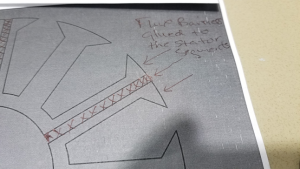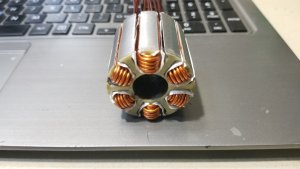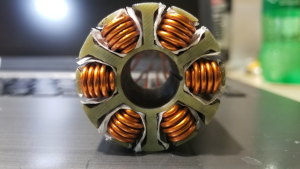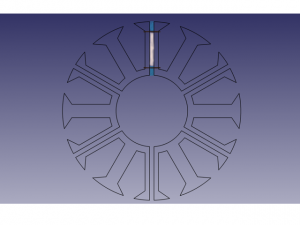Cohesive
User gesperrt
Hi,
I've been looking at areas of improvement for the HKIII series of scorpion stators. The first thing I note is that a single layer wind has a higher wind factor of about 3.3% than a dual layer but it suffers a lot of iron loss due to it's amplification of the fundamental. It is known that a novel way to minimize these losses are with the use of flux barriers. Information from Gurakuq Dajaku, and Dieter Gerling's study into this topic yielded the result that with a 12 slot 14 pole FSCW, a single layer sees more improvement than a dual layer from the use of flux barriers. They studied two types of barriers. Ones in the yolk region and ones in the tooth region. It was found that with a dual layer if the yolk was cut away every other slot by 65% this eliminated totally the fundamental but it also slightly reduced the 5th and 7th. Better but not the best. It was found with a single layer at 95% yolk cut away a reduction of 60% bringing the first to 9.03% just 2.3% higher than a conventional dual layer for this topology, while actually increasing the 5th and 7th. making it more efficient and raising it's torque output. The problem with yolk cutouts on these stators is they have a fairly thin yolk. The 4035 for instance has only about 1.5mm thickness so at .95% cut away you'd only have at the thinnest parts .75mm of yolk thickness. This may work but it seem like it would make an awfully fragile stator. Plus since it is a post facto design idea I don't know it the yolk was purposely designed thin here to purposely effect the flux distribution. Finally we come to the point of tooth flux barriers where the stator is basically segmented into 4 quarters of 2x 1/3 teeth with one full tooth in the middle with the flux barriers making up the middle third between each quarter stator segment. Doing this in a single layer showed significant reduction in the first and fifth harmonic with a significant increase in the 7th. the working harmonic for a 14 pole motor. Problem here is in the test they did a IPM and were doing EPM. That makes it difficult to assemble a stator we have no case to put in. This leads me to the idea that I can possibly do sort of booth with this stator. Simply have a basically the same dimensional stator cut but only cut away the middle third of each tooth all the way down halfway into the yolks thickness and insert the barrier strips. If this worked it would be great as the single layer 14 pole motor with could show a total 60% reduction of sub harmonics and a increase in torque output up to 16%. The 14 pole single layer would also have higher induction and much better field weakening capability. The only other ideas I can come up with are to design or start with a stator with more iron...a thicker yolk. The other thing that reduces sub harmonics is Gerling winding schemes.
I've been looking at areas of improvement for the HKIII series of scorpion stators. The first thing I note is that a single layer wind has a higher wind factor of about 3.3% than a dual layer but it suffers a lot of iron loss due to it's amplification of the fundamental. It is known that a novel way to minimize these losses are with the use of flux barriers. Information from Gurakuq Dajaku, and Dieter Gerling's study into this topic yielded the result that with a 12 slot 14 pole FSCW, a single layer sees more improvement than a dual layer from the use of flux barriers. They studied two types of barriers. Ones in the yolk region and ones in the tooth region. It was found that with a dual layer if the yolk was cut away every other slot by 65% this eliminated totally the fundamental but it also slightly reduced the 5th and 7th. Better but not the best. It was found with a single layer at 95% yolk cut away a reduction of 60% bringing the first to 9.03% just 2.3% higher than a conventional dual layer for this topology, while actually increasing the 5th and 7th. making it more efficient and raising it's torque output. The problem with yolk cutouts on these stators is they have a fairly thin yolk. The 4035 for instance has only about 1.5mm thickness so at .95% cut away you'd only have at the thinnest parts .75mm of yolk thickness. This may work but it seem like it would make an awfully fragile stator. Plus since it is a post facto design idea I don't know it the yolk was purposely designed thin here to purposely effect the flux distribution. Finally we come to the point of tooth flux barriers where the stator is basically segmented into 4 quarters of 2x 1/3 teeth with one full tooth in the middle with the flux barriers making up the middle third between each quarter stator segment. Doing this in a single layer showed significant reduction in the first and fifth harmonic with a significant increase in the 7th. the working harmonic for a 14 pole motor. Problem here is in the test they did a IPM and were doing EPM. That makes it difficult to assemble a stator we have no case to put in. This leads me to the idea that I can possibly do sort of booth with this stator. Simply have a basically the same dimensional stator cut but only cut away the middle third of each tooth all the way down halfway into the yolks thickness and insert the barrier strips. If this worked it would be great as the single layer 14 pole motor with could show a total 60% reduction of sub harmonics and a increase in torque output up to 16%. The 14 pole single layer would also have higher induction and much better field weakening capability. The only other ideas I can come up with are to design or start with a stator with more iron...a thicker yolk. The other thing that reduces sub harmonics is Gerling winding schemes.

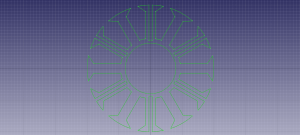
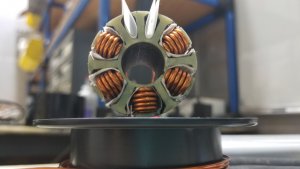
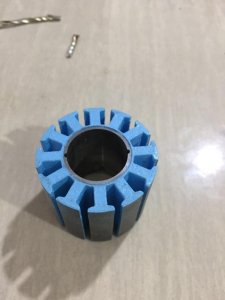
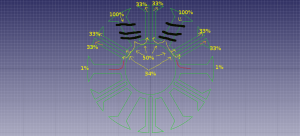
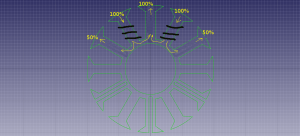


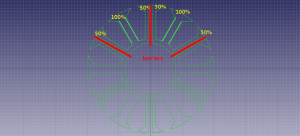

 But this "1/3" total tooth width number is where they found through testing the documented improvement and so we start there with our test. Do you have any suggestions?
But this "1/3" total tooth width number is where they found through testing the documented improvement and so we start there with our test. Do you have any suggestions?

